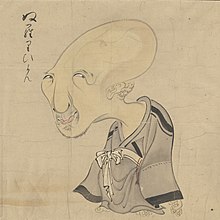Nurarihyon: Difference between revisions
Taikai2018 (talk | contribs) added detailed attribution information for first nurarihyon image |
m Bot: link syntax and minor changes |
||
| Line 1: | Line 1: | ||
[[File:10.Nurarihyon.jpg|thumb|Nurarihyon (ぬらりひょん) from [[Bakemono no e]] (化物之繪, c. 1700), Harry F. Bruning Collection of Japanese Books and Manuscripts, [[L. Tom Perry Special Collections Library|L. Tom Perry Special Collections]], [[Harold B. Lee Library]], [[Brigham Young University |
[[File:10.Nurarihyon.jpg|thumb|Nurarihyon (ぬらりひょん) from [[Bakemono no e]] (化物之繪, c. 1700), Harry F. Bruning Collection of Japanese Books and Manuscripts, [[L. Tom Perry Special Collections Library|L. Tom Perry Special Collections]], [[Harold B. Lee Library]], [[Brigham Young University]].|alt=]] |
||
{{Expand Japanese|ぬらりひょん|date=May 2016}} |
{{Expand Japanese|ぬらりひょん|date=May 2016}} |
||
[[File:SekienNurarihyon.jpg|right|thumb|150px|''Nurarihyon'', from [[Toriyama Sekien]] "[[Gazu Hyakki Yakō]]."]] |
[[File:SekienNurarihyon.jpg|right|thumb|150px|''Nurarihyon'', from [[Toriyama Sekien]] "[[Gazu Hyakki Yakō]]."]] |
||
| Line 9: | Line 9: | ||
==Appearance and behaviour== |
==Appearance and behaviour== |
||
[[File:Suuhi Nurarihyon.jpg|thumb|right|150px|''Nurarihyon'', from Sawaki Sūshi "[[Hyakkai Zukan]]."]] |
[[File:Suuhi Nurarihyon.jpg|thumb|right|150px|''Nurarihyon'', from Sawaki Sūshi "[[Hyakkai Zukan]]."]] |
||
The Nurarihyon is usually depicted as an old man with a [[gourd]]-shaped head and wearing a [[kesa (clothing)|kesa]].{{sfn|Meyer|2013|p="Nurarihyon"}} In some depictions he also carries a single sword rather than the standard two to demonstrate his wealth. There is speculation that in Toriyama Sekien’s portrayal of Nurarihyon, he serves as a political cartoon to represent the aristocracy. {{sfn|Yoda|2016|p=64}} Others suggest that he is retired from a samurai family due to the sword and his clothing style.{{sfn|Zenyoji|2015|p=230}} |
The Nurarihyon is usually depicted as an old man with a [[gourd]]-shaped head and wearing a [[kesa (clothing)|kesa]].{{sfn|Meyer|2013|p="Nurarihyon"}} In some depictions he also carries a single sword rather than the standard two to demonstrate his wealth. There is speculation that in Toriyama Sekien’s portrayal of Nurarihyon, he serves as a political cartoon to represent the aristocracy. {{sfn|Yoda|2016|p=64}} Others suggest that he is retired from a samurai family due to the sword and his clothing style.{{sfn|Zenyoji|2015|p=230}} |
||
The Nurarihyon is often depicted sneaking into people's houses while they are away, drinking their tea, and acting as if it is their own house.{{sfn|Foster|Kijin|2014|p=218}}{{sfn|Mizuki|1994|p=344-345}} However, this depiction is not one based in folklore, but one based on hearsay and repeated in popular Yōkai media.{{sfn|Foster|Kijin|2014|p=218}}{{sfn|Kyōgoku|Tada|2000|p=149}} |
The Nurarihyon is often depicted sneaking into people's houses while they are away, drinking their tea, and acting as if it is their own house.{{sfn|Foster|Kijin|2014|p=218}}{{sfn|Mizuki|1994|p=344-345}} However, this depiction is not one based in folklore, but one based on hearsay and repeated in popular Yōkai media.{{sfn|Foster|Kijin|2014|p=218}}{{sfn|Kyōgoku|Tada|2000|p=149}} |
||
Revision as of 20:49, 16 May 2019

You can help expand this article with text translated from the corresponding article in Japanese. (May 2016) Click [show] for important translation instructions.
|

Nurarihyon (ぬらりひょん, alternatively 滑瓢), or Nūrihyon (ぬうりひょん), is a Japanese Yōkai said to originate from Wakayama Prefecture. It is speculated that the original name used was Nūrihyon, with Nurarihyon being a misreading that got perpetuated.[1][2]
Etymology
The name Nurarihyon is a portmanteau of the words "Nurari" (Japanese: ぬらり or 滑) meaning "to slip away" and "hyon" (Japanese: ひょん or 瓢), an onomatopoeia used to describe something floating upwards. In the name, the sound "hyon" is represented by the character for "gourd".[3] The Nurarihyon is unrelated to another, similarly named ocean Yōkai from Okayama Prefecture.[4]
Appearance and behaviour

The Nurarihyon is usually depicted as an old man with a gourd-shaped head and wearing a kesa.[3] In some depictions he also carries a single sword rather than the standard two to demonstrate his wealth. There is speculation that in Toriyama Sekien’s portrayal of Nurarihyon, he serves as a political cartoon to represent the aristocracy. [5] Others suggest that he is retired from a samurai family due to the sword and his clothing style.[6]
The Nurarihyon is often depicted sneaking into people's houses while they are away, drinking their tea, and acting as if it is their own house.[4][7] However, this depiction is not one based in folklore, but one based on hearsay and repeated in popular Yōkai media.[4][8]
Notes
- ^ Murakami 2000, p. 255.
- ^ Kyōgoku & Tada 2000, p. 149-150.
- ^ a b Meyer 2013, p. "Nurarihyon".
- ^ a b c Foster & Kijin 2014, p. 218.
- ^ Yoda 2016, p. 64.
- ^ Zenyoji 2015, p. 230.
- ^ Mizuki 1994, p. 344-345.
- ^ Kyōgoku & Tada 2000, p. 149.
References
- Davisson, Zack (March 2015). "Back Matter: Nurarihyon". Wayward Volume One: String Theory. Image Comics. ISBN 978-1-63215-173-5.
{{cite book}}: Invalid|ref=harv(help) - Foster, Michael Dylan; Kijin, Shinonome (2014). The Book of Yōkai: Mysterious Creatures of Japanese Folklore. University of California Press. ISBN 9780520271029.
{{cite book}}: Invalid|ref=harv(help) - Kyōgoku, Natsuhiko; Tada, Katsumi (2000). Yōkai Zukan. Kokusho Kankōkai. ISBN 978-4336041876.
{{cite book}}: Invalid|ref=harv(help) - Meyer, Matthew (2013). "Nurarihyon". yokai.com. Retrieved 22 May 2016.
{{cite web}}: Invalid|ref=harv(help) - Mizuki, Shigeru (1994). Zusetsu Nihon Yōkai Taizen. Kōdansha. ISBN 9784062776028.
{{cite book}}: Invalid|ref=harv(help) - Murakami, Kenji (2000). Yōkai Jiten. Mainichi Shinbunsha. ISBN 978-4620314280.
{{cite book}}: Invalid|ref=harv(help) - Yoda, Hiroko (2016). Japandemonium Illustrated: The Yōkai Encyclopedias of Toriyama Sekien. Mineola, New York: Dover Publications, Inc. ISBN 9780486800356.
{{cite book}}: Invalid|ref=harv(help) - Zenyōji, Susumu (2015). E de miru Edo no yōkai zukan. Tokyo: Kōsaidō Shuppan. ISBN 9784331519578.
{{cite book}}: Invalid|ref=harv(help)
See also
External links
- Nurarihyon – The Slippery Gourd at hyakumonogatari.com (English).
- Nurarihyon from Yōkai on Mizuki Shigeru Road: Sakaiminato Sightseeing Guide Template:Ja
